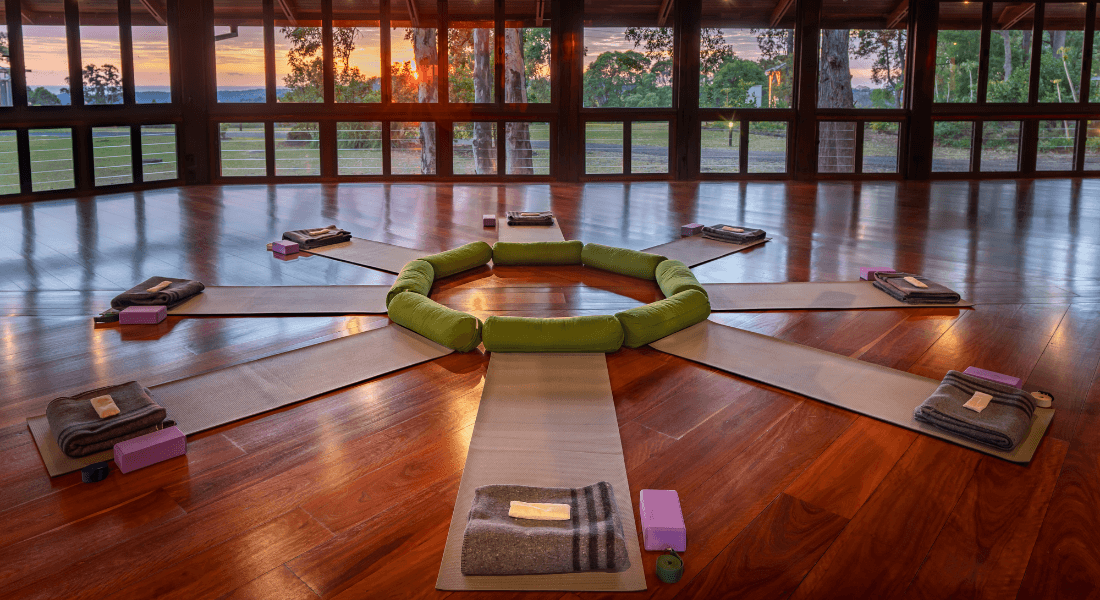For thousands of years, yoga has been a tool to open the mind and body, bringing transformation.
At its core, yoga is a process that involves confronting your limits and transcending them.
Yoga is a very holistic way to train your body because there is so much emphasis on flow, surrender and breath.
The essence of yoga is not achievements but how you work with your limits, wherever and whatever they may be.
The important thing is not how far you get in any given pose, but how you approach the yogic process, which in turn is directly related to how your mind views yoga.
Why yoga helps to reduce stress
Yoga is a self-soothing technique that involves mindful breathing and conscious movement.
When performed correctly, the act of yoga can lower the heart rate, reduce the impact of stress and sequentially restore a sense of calm to the mind and body.
If you suffer from stress and anxiety, you might like to try these five yoga poses for relaxation and stress management.
Five of our favourite calming yoga poses for stress relief
CAT/COW POSE (MARJARYASANA/BITILASANA)
The cat/cow pose is generally a movement performed at the beginning of a session to warm up the body and gently stimulate the core.
The pose involves taking a stance on all fours and slowly alternating between concave and convex of the spine, torso and neck.
By alternating between cat and cow pose, essentially you are relaxing the neck and shoulders and massaging the spine all whilst maintaining a slow and deep breath.
The sequence encourages awareness and presence in body and breath, which can help to resolve feelings of stress.
LEGS UP THE WALL (VIPARITA KARANI)
Legs up the Wall is a restorative yoga pose, perfect for helping to bring a sense of calm, and refreshed energy; best practised after a busy day, and/or during times of stress.
To practice Viparita Karani, you will need a wall, and perhaps a folded blanket or two.
The folded blanket/s can be placed on the floor, with the edge against the wall, as a support beneath your sacral area.
As you lay on the floor with your bottom close to or against the wall, elevate your legs resting on the wall in a vertical, or almost vertical position.
With a bit of practice, you will find the easiest way to move into this position.
While in the pose, you might like to rest your hands on your belly, close your eyes, and gently draw your chin towards your throat (lengthening the back of your neck).
Breathe deeply into your belly, relaxing through your lower back and the backs of your legs with each exhalation.
Stay for up to ten minutes.
This pose will gently stretch the backs of your legs and works on the circulatory and nervous systems.
Restored energy and enhanced inner peace may come as a result.
CHILD’S POSE (BALASANA)
This pose is deeply relaxing and can be beneficial in relieving headaches and calming the central nervous system.
It involves kneeling on the floor or mat with your heels separated and big toes touching.
Your knees should be positioned to the width of your shoulders and your torso should lay back to be resting on top of your thighs.
Your arms stretch out in front of you, and your forehead can gently be resting on the mat.
Close your eyes if this is comfortable and focus on slowing your breath.
If your attention wanders, simply notice and then return your attention to your breathing.
Stay in the pose for 5-15 minutes, or less if you experience pain or discomfort.
By grounding your mind to the earth and breathing slowly, you can experience a sense of calm.
MOUNTAIN POSE (TADASANA)
Mountain pose involves drawing your awareness inwards and standing with your feet together, and toes pointed apart.
Your hips should be perfectly centred, shoulder blades back and arms to your side with your palms facing forward.
You should feel every muscle in your body, working together to maintain balance.
By redirecting your mind inward and focusing all of your awareness within your body, you will experience a brief disconnect from the outer world.
The mountain pose is also the starting posture for the next calming yoga pose for stress relief.
SAVASANA
The fifth yoga pose for relaxation and stress management is corpse pose.
As the pose that requires total relaxation, savasana is often the final pose of the practice.
To perform this, lie on your back with your neck naturally elongated, and hands down by your side, palms facing up.
Some people find it beneficial to place a pillow or blanket under your knees to allow the end of your spine to rest on the floor.
You might also find added comfort in placing a blanket over yourself.
Incorporate yoga poses for relaxation and stress management into your daily routine
Dedicate time to relax and recharge, with calming yoga poses for stress relief.
If you find yourself experiencing high levels of prolonged stress, your body might be telling you it's time for a break.
Gwinganna is a destination to soothe your soul and inspire a healthier life.
Find out more about our wellness retreats and how they might be the much-needed escape you’ve been longing for.




